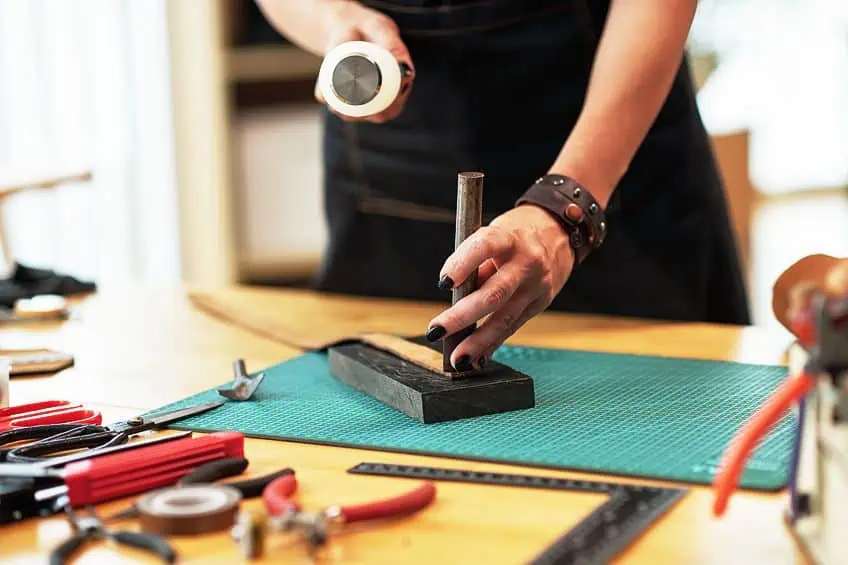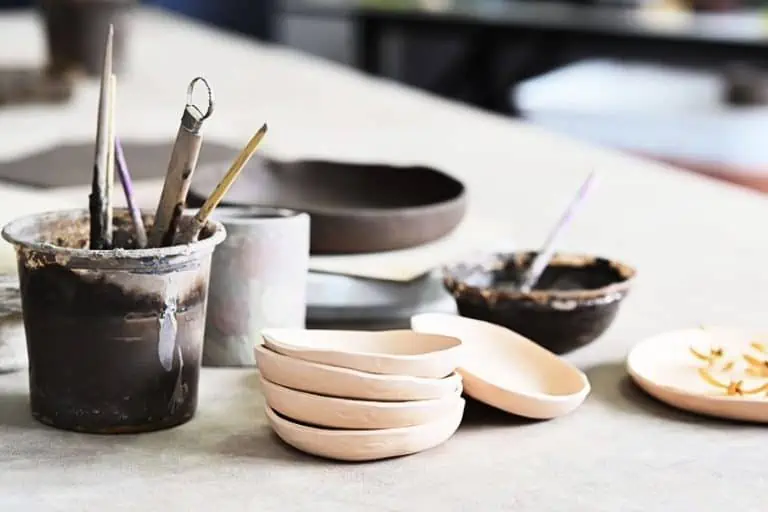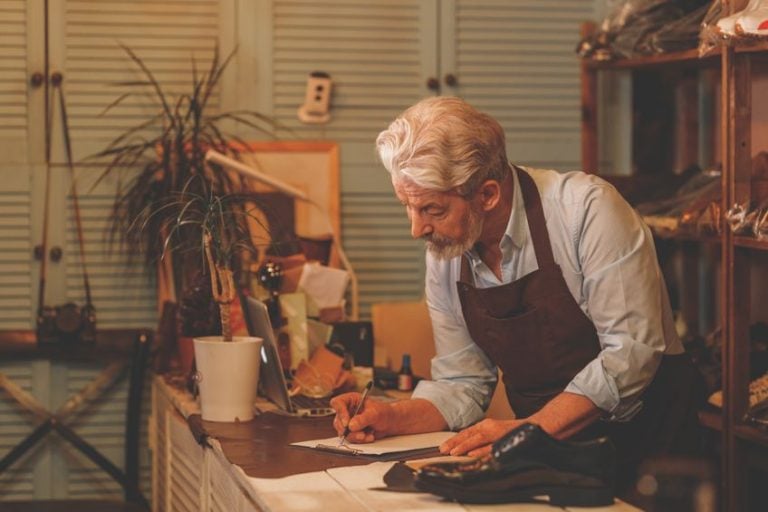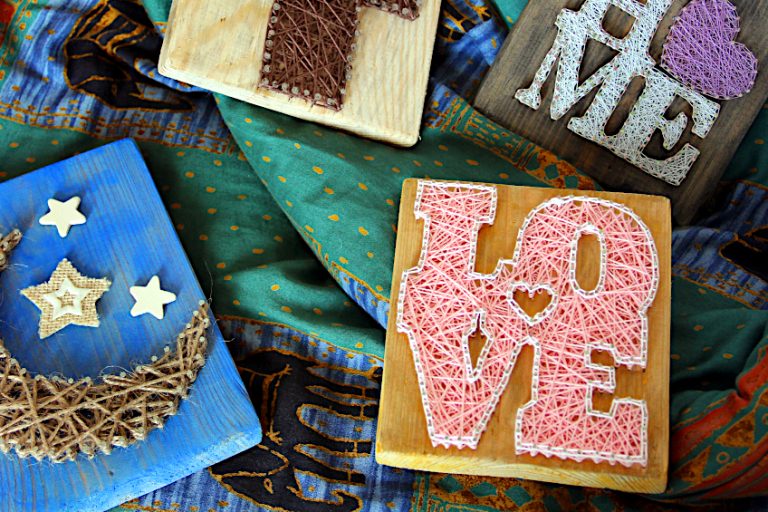How to Engrave Leather – Learn the Art of Leather Engraving
This post may contain affiliate links. We may earn a small commission from purchases made through them, at no additional cost to you.
Leather is a timeless material; it can last forever and is a material that has been around for centuries. It is also a material that has a natural hardness and durability, making it suitable for leather crafters and DIY enthusiasts. Let us help guide you through the process of how to engrave leather below.
Table of Contents
What Is Leather Engraving?
The art of leather engraving is an age-old craft that has been practiced for centuries, and there is nothing more beautiful than a simple monogram letter, or a more intricate design that is engraved into a leather surface. Leather engraving is a particular process where you can personalize any leather product or item with a permanent design, which can be etched into the leather surface.
This engraving or etching process makes use of certain tools that stamp or cut the design into the leather surface, leaving you with a permanent and beautiful leather item.
There are various methods or techniques used to achieve this result that include laser engraving, hand engraving, embossing, branding, carving, and pyrography. Each one of these techniques gives your leather items different appearances. Below are a few leather item examples that can be used.

- Leather wallet
- Purse or handbag
- Luggage bag
- Photo album
- Notebook
- Bookmark
- Belt
- Jacket
- Waistcoat
- Knife cover
- Musical instrument bag
This is not only an art that is practiced by the leather craftsman, but with a little practice, you too can start to customize your own clothing and equipment, making them very special to you and your friends and family. Let us now help you to understand how to engrave leather.
How to Engrave Leather
You need certain tools and equipment for the leather engraving process. Depending on what process you want to use, the equipment you need can change. Let us now consider some of the materials and tools needed for leather engraving.

- Leather item
- Engraving tools and accessories
- Knife or leather shears
- Stamps
- Design
- Water
- Sponge
Preparation
The piece of leather you are going to engrave on needs to be properly fixed to the surface you are going to use. This helps to prevent it from shifting when busy with the engraving process. This can be achieved by taping or clamping the leather piece to the surface you are going to use. Next, take a damp sponge and use it to wipe and clean the leather surface.
The water will soften the leather slightly, making it easier to engrave.
Choose Your Design
You need to select the design you want to engrave on your leather item. To do this, there are two options. First, you can use your imagination and draw a design yourself, which can be a family crest or just your initials, or you can get your inspiration from another source like Pinterest, Instagram, or an online search.
Transfer the Leather Design
Once you are satisfied with your design, it is time to transfer it onto the leather. You first need to slightly dampen your leather surface, then hand draw your image or design onto a piece of tracing paper. Next, take the paper and lay it face down onto the leather where you want your image to appear. Make sure the tracing paper is fixed into a position that it cannot move around, then take a tracing tool, or awl, and draw over your design pressing down hard.
This does not transfer the pencil marking onto the leather but merely makes an indent into the leather surface, enabling you to emboss it, etch it, or burn it into the leather.

However, to do a more intricate design, you need to take the design or image from your computer and print it out onto a piece of paper. Then take the piece of paper and lay it face down onto the leather where you want to design to go. Soak a cotton bud in some acetone, and rub the paper over the design, this will cause the ink to be transferred from the paper to the leather surface.
Preparing the Leather
Before you start to engrave, you need to prepare the leather first. You need to ensure that the leather is good quality and does not have a finish on the surface. Then you need to gather all the tools you will need together, like engraving tools, water, sponge, and leather shears. If you are using a separate piece of leather for your project, you need to cut the leather to the size and shape that you want. You can overlook this step if you have an already existing leather item, like a belt, or wallet. The next step is to soak the leather in some water for about 20 to 30 minutes and wait for it to dry.
You can also try using a sponge to dampen the leather. This is done to soften the leather, making it easier to work with, and your leather is ready to start engraving.

Different Techniques for Engraving Leather
Leather is a naturally beautiful type of material, and can be personalized by engraving designs, letters, borders, and even colors, on various leather items. To do this, there are various techniques you can apply, and one of these is engraving. We are now going to describe a few techniques you can try.
Hand Engraving
The process of hand engraving has several variations or different techniques that will give the leather a brand-new appearance, by engraving the top layer of the leather surface. We are going to explain to you the leather engraving process and what tools to use.
Carving or Etching Leather
Leather carving is used to carve your design by hand into the leather. This process involves cutting away the top layer of the leather surface, creating a 3D appearance. The carved portion of the leather surface gives a sunken appearance compared to the rest of the surrounding leather surface and is known as leather etching.
The tools you will need for leather etching include a swivel knife, a chisel, and a scraper.

If you are only starting to engrave leather, there is also an engraving pen that you can use. The engraving pen is electricity or battery-operated, making it much easier for you to use. After you have wet the leather surface and transferred your design, take the swivel knife or engraving pen, cut along the lines you have drawn, and the process of etching leather is complete.
Branding or Hot Stamping Leather
This is one of the simplest methods to use for engraving leather and is used mainly for customized lettering of your name onto a leather wallet or bag. It involves pressing a hot metal object onto the leather surface, much like the farmer would brand his cattle. This leaves the design or image sunken into the surface and standing out from the surrounding leather surface. The tool you will need is a branding iron that has several temperature settings, allowing you to burn the design into the leather surface.
If you do not have a branding iron, but you do have your design on a standard metal stamp, you can heat the stamp in your electric oven, or on the electric plate.

After you have wet the leather surface, heat the stamp or iron to the required temperature. The greater the temperature, the darker the burnt image. The image burnt onto your leather surface will also be darker, the harder and longer you press. Your branding process is now complete.
Embossing and Debossing Leather
How to emboss leather? The embossing process of engraving is where you can create a combination of recessed and raised patterns on the leather surface. The embossing raises the pattern, while the debossing sinks the pattern into the leather surface. The tools you will need are different types of stamping tools and a stamping hammer. After you have wet the surface of the leather, place the stamp onto the leather in the position you want.
Next, take the stamping hammer and strike the stamp until you have the desired image engraved on the leather surface. This is the basic process to follow when learning how to emboss leather.

Pyrography
Pyrography is another burning technique for engraving or decorating leather surfaces, but instead of using a branding iron, you use a sharper tool that is more pointed. This enables you to create more detailed and unique patterns and images, where you can write or draw on the leather surface. The tool you will need is a pyrography pen that has different types of bits or tips, which helps you to draw lines or patterns that are thick or thin. This tool is considered to be risk-free, but it is advisable to use gloves when using it. The tool can be electric or powered by batteries.
After you have wet the leather surface, heat the pyrography pen to the desired temperature, which depends on what mark you want to burn, whether it will be light or dark.

Then start drawing your design or pattern on the leather surface, and the pyrography engraving process is complete. There are still a few more hand-engraving techniques that we have not covered, such as foiling., where you can engrave with color. Then there is also perforation, where holes are punched into the leather to give the image or pattern, and embroidery, where sewing thread is used to create the design or pattern.
Laser Engraving Leather
Laser engraving on leather is a more up-to-date and modern method and can engrave more detailed designs and patterns with pinpoint accuracy and precision. The laser beam carves your design or pattern on the leather surface, as it burns the surface layer. You will need a laser engraving machine to do the job, with basic to advanced models available.
If you are doing your engraving as a DIY hobby, then it is best to use a smaller type that also comes in a tabletop model.

For it to work properly, you need to install the software on your smartphone or computer and connect it to the laser machine, which will send the pattern or image to the laser machine. Then you need to place your leather item in the correct position, switch the machine on and the laser will engrave the image on your leather surface. The laser machine is safe to use, but you may want to protect your eyes with a pair of tinted glasses.
Rotary Engraving Leather
If you have a leather item at home and you want to give it a personalized touch with some detailed designs and patterns, then the rotary engraving tool is the answer. The rotary engraving tool is versatile and easy to use, and you can add uniqueness to your leather item without much effort. You need to have a rotary engraving tool that can be cordless or dependent on a power supply. It also comes with different engraving bits, and choosing the right bit is vital for the best results. There are carbide bits that can create deep and precise cuts, diamond bits that last much longer, and high-speed bits that are ideal for engraving on leather.
Before you start to engrave, make sure that your leather item is securely held in place with a clamp or other fixing device.

Now adjust the speed of the tool; a faster speed will give you a rough deep cut, while a slower speed will give you a shallower and smother cut and is best used for finer details and intricate designs. There are three techniques you can apply when using the rotary engraving tool, which is freehand engraving, where you draw your design freehand, which is best for simple patterns and designs. Then there is stencil engraving, where you use a stencil to create the design on your leather surface. Lastly, there is dot engraving, where you create dots to form your design and then simply join the dots.
Burnishing Leather
Burnishing is giving your leather a perfect finish by removing rough edges and leaving it with a shiny, high-quality look, suitable for shoes, boots, and belts. This may be a tedious job, but the results are amazing. Burnishing your leather item requires that you cut away the loose fibers, giving you a frayed and raw appearance. You will need certain tools for this technique that will include the following.

- Beveler
- Sandpaper
- Buffing cloth
- Gum
- Beeswax, or paraffin wax
Start by sanding the edges of the leather item to achieve a smooth finish. The heat produced by the friction of the sanding will bind the leather and give it a polished edge. Next, take the beveler and run it over the edges, which will leave the edges rounded, ensuring that the leather does not fold. Now you need to take the gum, beeswax, or paraffin wax and coat the edges with the compound, which will make the leather hard and seal the leather edges.
If you do not have any of these compounds available, then water will work just as well.
Lastly, you need to burnish the leather edges by using a hard object that must not be abrasive, like a piece of wood. Rub the leather edges until it begins to shine. Now you need to allow the leather to air dry but do not put it into direct sunlight as this may change the color of your leather.
Maintenance and Care
Leather is a tough and durable material, but it can wear down and begin to crack. So, it needs to be handled with care, especially if you do not have experience with looking after leather products. Here are some tips for you to follow, which will give your leather new life, and make it last for much longer.

Using Too Much Water
When using too much water on your leather product, it can compromise the leather. So, do not use too much water when cleaning your shoes or other leather products, it only requires a minimal amount of water.
Using Soap
Soap can be used to clean almost anything, but leather is not one of them, as soap on your leather product can cause the leather to dry out and become damaged. Try to find a cleaning product that can be used on the leather without damaging the leather.

Cleaning Too Often
It is not a good idea to clean leather too often as the leather needs some time to dry out properly. This dying-out process is important to allow the leather to harden, making it much more difficult for moisture to enter the pores and cause damage. Once a month is a good time for cleaning.
Sealing the Leather
Once you have completed your engraving on your leather product, you need to seal your work. This is because leather is a natural product, and once the top layer has been removed, it needs to be sealed. Some of the best products to use for this process are beeswax, neatsfoot oil, or saddle soap.

Tips for Engraving Leather
The most important thing to understand when you want to engrave your leather items is that you do not have to spend a lot of money on special equipment, and it can be done in your own home. The most important tip to consider when engraving leather is to ensure you use the correct type of leather. The best type is full-grain leather, as it is strong enough to handle any engraving technique.
When using the perforating and embroidery technique, thin leather is preferable, and try to use animal-tanned leather.
Wetting the leather surface before you start to engrave is a good idea, as it makes the leather easier to handle and can be molded into any design much better. Try not to soak the leather, only wet the top layer, especially when using the embroidery and perforation technique. Below are a few more leather engraving tips.

- Wear protective clothing, such as an apron to protect your clothes and body, and protective eyewear to protect your eyes.
- Take care when using sharp instruments that may cut your hands and fingers.
- Keep your hands and fingers away from any moving machinery, or when using punchers, bevelers, or edgers.
- Some leather products use chemicals to dye the leather, so try to ventilate your working area to avoid breathing in any fumes that may be toxic.
Common Mistakes Made During Leather Engraving and How to Avoid Them
The techniques used for leather engraving can be applied to several different leather products, like belts, shoes, wallets, and much more. However, some mistakes can occur during the engraving process, which can affect the results.

- Using the incorrect tools can damage the leather and give you a poor result.
- Applying too much pressure can make uneven marks and distort the leather.
- Using low-quality leather can lead to a poor finished product.
- Not practicing on a piece of scrap leather first can lead to very expensive mistakes in your final product.
- Working with the leather before it is properly dry can weaken the leather and cause your design to distort.
- Make sure your cutting tools are sharp, a dull blade can cause uneven cuts and jagged edges.
- Leather engraving is a skill that needs practice, take time to practice before working on the final product.
- If it is an intricate design try to break it up into sections, which will help to maintain accuracy and consistency.
The information and leather techniques we have shared with you in this article should provide you with enough confidence to try your hand at some leather work. Each of these techniques has advantages, disadvantages, and risks, which you need to be aware of. But, with a little practice, you will be able to produce some amazing designs and patterns on many of the leather-based items in your home.
Frequently Asked Questions
Can Any Type of Leather Be Engraved?
Any type of leather is suitable for engraving, which can include deerskin, lambskin, cowhide, and sheepskin. However, the best leather to use is genuine high-quality leather that has a full grain, as it is the thickest and the strongest.
Can You Dye Engraved Leather?
Once you have engraved the letters on your leather product, paint them with whatever color suits you. Seal the letters with what is known as a resist, which highlights your work. Now you can dye the leather item and your resist will wipe off all the paint you applied, leaving the highlighted letters behind.
How Deep Should Leather Engraving Be?
The depth of engraving on your leather is very important, as you do not want to go too deep and weaken the leather. In general, the depth of your engraving should not be more than half the depth of your leather.
In 2005, Charlene completed her wellness degrees in therapeutic aromatherapy and reflexology at the International School of Reflexology and Meridian Therapy. She worked for a company offering corporate wellness programs for several years before opening her own therapy practice. In 2015, she was asked by a digital marketer friend to join her company as a content creator, and it was here that she discovered her enthusiasm for writing. Since entering the world of content creation, she has gained a lot of experience over the years writing about various topics such as beauty, health, wellness, travel, crafting, and much more. Due to various circumstances, she had to give up her therapy practice and now works as a freelance writer. Since she is a very creative person and as a balance to writing likes to be active in various areas of art and crafts, the activity at acrylgiessen.com is perfect for her to contribute their knowledge and experience in various creative topics.
Learn more about Charlene Lewis and about us.







